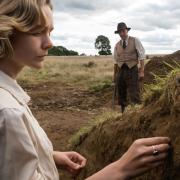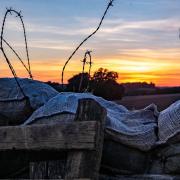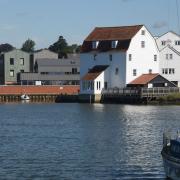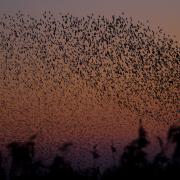What can we do to protect creatures such as the turtle dove and hazel dormouse?

One of the undoubted privileges of living in rural Suffolk is a sense of immunity from the world’s woes.
Elsewhere, the world may be going to hell in a handcart – wildfires, gun crime and rampaging Covid – but in our comparatively peaceful corner of eastern England the big skies and pink cottages help to ease our mostly untroubled minds.
If you watched David Attenborough’s latest programme, Extinction: The Facts, which aired mid-September, you may be forgiven for thinking the same applies when it comes to the crisis in biodiversity. Attenborough has spent the majority of his incredible life bringing the wonders of the natural world into our living rooms but his latest documentary sent a chilling message – much of that wildlife is under intense threat.
The basis of his programme was a recent jaw-dropping United Nations report that states up to 1 million species from across the animal kingdom face extinction unless urgent action is taken. We saw heart-breaking images – from Central Africa, home to the world’s last two surviving northern white rhinos, from Australia where koalas, injured and scared, try to escape bushfires, from South America where giant anteaters are in decline as their savannah habitat is turned over to grazing lands.

It all seemed, literally, thousands of miles from sleepy Suffolk. But, in our own way, we are facing the same crucial challenges.
Where to see spectacular starling murmurations in Suffolk

The birds and bees... and the natterjack toad
Every wildlife conservation group has similar stories of species declining significantly in the east, driven by the four riders of the biodiversity crisis – fragmented habitats, intense farming methods, over-development and climate change.
At insect conservation charity, Buglife, director Paul Hetherington points to a recent Bees Under Siege report that found in the East of England 17 species of bee are now extinct and 25 species, such as the shrill carder bee and sea aster mining bee, are threatened.
The charity is campaigning for more wildflower verges and meadows to be developed, so all insects have a connected network to move around. At stake is more than the loss of some interesting and beautiful creatures. Pollinators such as bees are worth a staggering £690 million per annum to the UK economy because they pollinate 75per cent of leading global crops, including oilseed rape, apples and beans.

Paul Stancliffe, communications officer at the Thetford-based British Trust for Ornithology, warns that the curlew and turtle dove are two birds in danger of disappearing from the Suffolk landscape. Both have struggled as farming practices have changed over the past half-century. Whereas pre-war fallow and scrub land was left, providing space for birds to nest and feed, today, on the majority of farms, all available land is tilled, pushing these iconic species to the fringes.
Also on the fringes in Suffolk are the natterjack toad and great crested newt, according to Yvette Martin at the Amphibian and Reptile Conservation charity. She says the ongoing practice of draining farmer’s ponds has hit the great-crested newt population hard while the natterjack is now only found in two locations in Suffolk – Minsmere and Sizewell.
“No other amphibian in the UK sounds like the natterjack toad,” says Martin. “Their call can be heard in loud choirs after rain in April and May – it sounds like the tropics. They are of huge cultural significance.”
Lose some, win some
At the Suffolk Biodiversity Information Service, manager Martin Sandford points out that extinction is a dynamic process. Over time, species do die out or disappear from a region while new species appear. East Anglia is particularly susceptible to species coming and going because of its location. Facing Europe, it is at the edge of the range of a number of insects and birds which may be common on the Continent but have only a toehold in the UK.
Our region may have lost the magnificent Large Copper butterfly when it became extinct in the British Isles in the mid-nineteenth century after the draining of the Fens took away its habitat. But naturalists today are eagerly awaiting the arrival of the southern small white butterfly, which has been increasing its range northwards from southern Europe in the past decade and is expected to hop The Channel any summer soon.
White storks were hunted to extinction in the UK 600 years ago but in recent years they have returned, with reports of breeding pairs in Norfolk. Warmer weather brought on by climate change, and conservation efforts to create wetlands have driven this homecoming. It’s down to the same factors that you can now see cranes in Lakenheath, spoonbills on Havergate Island, off the coast at Orford and different species of egret across Suffolk.
Sandford says the withdrawal of species does not convey the whole story of the biodiversity crisis facing East Anglia. What is more telling, he says, is the loss of the abundance of wildlife from our region. There’s just not as much around as there used to be. Where, for example, are the thousands of roadside verges of yesteryear teeming with cowslips? While only a generation ago many gardens had a resident hedgehog, today their presence is unusual. Incredibly, the house sparrow is now red-listed as a species of high conservation concern.
And this dearth in the richness in wildlife is most starkly illustrated if you look under a microscope.
“There’s a hundred times more microscopic life in a sample of soil from an ancient woodland than a sample taken from agricultural land,” continues Mr Sandford. “We’ve lost the ability of soil to regenerate itself. That process has been replaced by us putting in fertilisers, which is expensive and uses resources. In some cases, fish is still being used to make fertiliser, it’s a crazy situation.”
Hope on the horizon?
Is there any hope that this situation can be reversed? Head of conservation at the Suffolk Wildlife Trust, Ben McFarland, points out that there have been some landmark successes in bringing wildlife populations back from the brink of extinction in Suffolk.
Some raptor species, such as buzzard and kites, are doing well here because they are no longer persecuted. Along the coast, bitterns are booming, while both marsh harrier and avocet populations are growing when once there was fear they would disappear altogether.
But these heart-lifting success stories have happened as a result of directed conservation efforts. McFarland says there needs to be recognition of the crucial role wildlife plays on a wider scale, not only in itself, but towards our own survival. He is hopeful that a United Nations-led campaign to see 30 percent of the world’s land set aside for wildlife will focus minds.
“As a society we need to understand what nature could do for us,” continues McFarland. “We know from lockdown how important walking in a nature-rich environment can be for mental health. How much pressure can nature take off the NHS?
“We know that wetlands are important for carbon storage and that river basins have a role to play in flood alleviation. There’s so much that nature can do for us.”
Five species in danger of disappearing from Suffolk
Sea aster mining bee
Restricted to the margins of salt marshes in East Anglia, the rare sea aster mining bee is named after its preferred food source, sea aster, which flowers at the same time as the bee’s August emergence when they collect pollen and nectar for their young. However, climate change and sea level rise are causing their saltmarsh habitats to be lost.
Turtle dove
Once a common sight in East Anglia, turtle doves are now rarely spotted having suffered a 91 percent UK population decline since 1995 - and there are fears that at this rate the bird’s’ UK extinction as a breeding species is a real possibility. Loss of habitat and over-hunting on their long migratory route from West Africa are thought to be key reasons for the drastic fall in numbers.
Hazel dormouse
Already under threat because of fragmented woodland and the ongoing loss of hedgerows, numbers of dormice have declined by 72 per cent in 22 years, according to figures from the People’s Trust for Endangered Species (PTES). The lack of management of woodlands, meaning taller trees are crowding out the shrub level where the dormouse thrives, is one reason for the fall.
Natterjack toad
Natterjack toads used to be distributed across 12 heath and coastal locations in Suffolk but today they can only be found at two: Minsmere and Sizewell – the latter at risk of development with proposals for a new nuclear plant on the site. What’s more, there are fears that sea level rises will result in the loss of the natterjack’s transitional habitat on the Suffolk coast, pushing the toad to extinction in the county.
Curlew
The winter arrival of curlews from Scandinavia to the East Anglian coast gives the impression there are an abundance of this curved-beak icon. But in fact, England has lost 60 per cent of its breeding curlews in the last 20 years. Changing farming methods and predation are two factors that have taken a toll



























